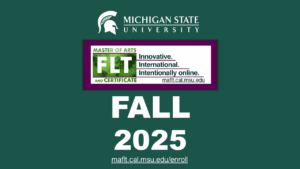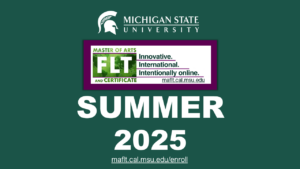Dr. Frederick Poole reports from CALICO 2024 in Pittsburgh
This year I attended the Computer Assisted Language Instruction Consortium (CALICO) Conference in Pittsburgh at Carnegie Mellon University. Many of you are likely familiar with your local and state language learning conferences and may be familiar with larger regional conferences like SCOLT and/or national conferences like ACTFL. However, there are also more niche conferences that are specific to subfields of Applied Linguistics. CALICO is the largest conference that focuses on the integration of technology for language teaching and often pulls scholars from all over the globe. While it is not nearly as big as most regional or national conferences, it is easily one of my favorite conferences to attend. Since technology is my main area of focus, I am very familiar with many of the presenters at this conference, there are always lots of fun and engaging activities (Board game night this year!) at the conference, and the presentation topics are often innovative and forward thinking.

Can you find Fred in the crowd?
Frederick Cornillie Delivering the Plenary Speech at CALICO 2024
Much of this conference was unsurprisingly focused on AI, but there were also several presentations on games, innovative research practices, among many other topics. I was involved in three presentations (admittedly more than I should have taken on). My first presentation was with a friend of mine Jason Kappes. Jason is the indie developer of an exciting new language learning game called Newcomer (See link for a trailer of his game, https://www.youtube.com/watch?v=TsRmCFswhkQ). I have been providing consulting support for Jason on the game for the past year and a half. In our presentation called “Using Data Analytics to Explore the Impact of a Task-based Digital Game on Learners’ Affect” we illustrated how we could extract data from Jason’s game to explore student interest, engagement and learning within the game. This was a very exploratory study and thus was not ready for publication, but we did want to show this at CALICO to get some feedback before continuing to the project.

My second presentation was with Matt Coss, a PhD student the in the Second Language Studies program here at Michigan State University. We explored the potential of using ChatGPT as an assessment tool in the Chinese classroom. Our presentation was called “Can ChatGPT Reliably Score L2 Writing Assessments? The Devil is in the Prompt.” In our presentation we used 10 different prompts and illustrated how prompts can drastically change the reliability and accuracy of ChatGPT as a rater for a writing prompt (See figure 3). We argue that ChatGPT can be good as a second rater or as a self-assessment tool when teachers and learners have been taught how to properly prompt ChatGPT. This presentation was actually just published in the Journal of Technology for Chinese Language Teaching. You can read it at the following link: http://www.tclt.us/journal/2024v15n1/JTCLT2024v15n1.pdf

Finally, I organized a panel of three speakers to talk about research practice partnerships around games for language learning. It’s important to note that the theme of the conference was building bridges between academia and industry. I made a point in the panel to argue that we are not simply building bridges between two points, but instead we should be building connections between industry, academics, and teachers. While some may argue that teachers are already included in the academics part, I felt it necessary to make it explicit. The first speaker I invited was Jason Kappes. He talked about the development of his game, what he must consider when building and promoting it, and how working with me and other colleagues supported the development of his game. Next, I invited Daniel Dixon who is a professor at Georgia State University. Dr. Dixon does exciting research around games illustrating their impact on learning. I asked him to discuss the current state of research on games and what partnerships between scholars and educators might look like. Finally. I invited James York, who is a professor out of Meiji University in Japan and also the founder of Ludic Language Pedagogy, to talk about teaching with games. Dr. York has been teaching English and Japanese with games for over 10 years now and has been a strong voice in promoting better research that supports teachers.

All three of these presentations were well received, but I think the panel ultimately helped many of the attendees see how industry, researchers, and teachers could and should collaborate to create better learning environments. Our panel in many ways echoed what the Plenary speaker, Frederick Cornillie, discussed in his talk. He emphasized that academics need to stop trying to do it all, and rather lean into their area of expertise and focus more on collaborating with others who have expertise (e.g. technology design, classroom teaching, etc.). I had a wonderful time at CALICO and will most definitely be returning in the near future. If you are interested in technology, I highly recommend following this conference and attending when it comes near to you.


